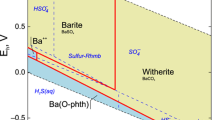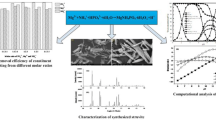Abstract
Nutrients such as nitrate and phosphate can enter aquatic systems through surface runoff and groundwater flow, which may cause eutrophication. To alleviate this environmental problem, removal of nutrients from both groundwater and surface water is required. The purpose of this study was to develop a chemical reagent and to evaluate its effectiveness at removing nitrate and phosphate. Ca-citrate was proposed as a chemical reagent and was prepared in its solid form that can be applied to both groundwater and surface water. A batch experiment was conducted to confirm the feasibility of simultaneously removing nitrate and phosphate. The experimental results showed that nitrate concentrations were reduced from 11.16 mmol L−1 to 0.01 mmol L−1 after 48 h. The formation of nitrite suggested that denitrification is the mechanism by which nitrate is removed. The concentration of phosphate decreased from 10.35 mmol L−1 to 0.53 mmol L−1 over 120 h. Visual inspection of white precipitates and calculation of saturation indices indicated that phosphate was removed via precipitation of hydroxyapatite, a Ca-phosphate mineral. This study suggests that the solid form of Ca-citrate may be used as a reagent to simultaneously remove nitrate and phosphate from groundwater and surface water.







Similar content being viewed by others
Availability of data and materials
Not applicable.
Code availability
Not applicable.
References
Apelblat A (2014) Citric Acid. Springer, New York
APHA (2012) Standard methods for the examination of water and wastewater, 22nd edn. American Public Health Association (APHA), Washington
Benson VS, VanLeeuwen JA, Sanchez J, Dohoo IR, Somers GH (2006) Spatial analysis of land use impact on ground water nitrate concentrations. J Environ Qual 35:421–432
Burow KR, Nolan BT, Rupert MG, Dubrovsky NM (2010) Nitrate in groundwater of the United States, 1991–2003. Environ Sci Technol 44:4988–4997
Carpenter SR, Caraco NF, Correll DL, Howarth RW, Sharpley AN, Smith VH (1998) Nonpoint pollution of surface waters with phosphorus and nitrogen. Ecol Appl 8:559–568
Cho DW, Song H, Schwartz FW, Kim B, Jeon BH (2015) The role of magnetite nanoparticles in the reduction of nitrate in groundwater by zero-valent iron. Chemosphere 125:41–49
Conley DJ, Paerl HW, Howarth RW, Boesch DF, Seitzinger SP, Havens KE, Lancelot C, Likens GE (2009) Controlling eutrophication: nitrogen and phosphorus. Science 323:1014–1015
Curie F, Ducharne A, Bendjoudi H, Billen G (2011) Spatialization of denitrification by river corridors in regional-scale watersheds: case study of the Seine river basin. Phys Chem Earth 36:530–538
David MB, Wall LG, Royer TV, Tank JL (2006) Denitrification and the nitrogen budget of a reservoir in an agricultural landscape. Ecol Appl 16:2177–2190
Dias S, Mucha AP, Duarte Crespo R, Rodrigues P, Almeida CMR (2020) Livestock wastewater treatment in constructed wetlands for agriculture reuse. Int J Environ Res Public Health 17:8592
Dubrovsky NM, Burow KR, Clark GM, Gronberg JAM, Hamilton PA, Hitt KJ, Mueller DK, Munn MD, Nolan BT, Puckett LJ, Rupert MG, Short TM, Spahr NE, Sprague LA, Wilber WG (2010) Nutrients in the nation’s streams and groundwater 1992–2004. US Geological Survey: Circular, Reston, p 1350
Eljamal O, Thompson IP, Maamoun I, Shubair T, Eljamal K, Lueangwattanapong K, Sugihara Y (2020) Investigating the design parameters for a permeable reactive barrier consisting of nanoscale zero-valent iron and bimetallic iron/copper for phosphate removal. J Mol Liq 299:112144
Fernández-Nava Y, Marañón E, Soons J, Castrillón L (2010) Denitrification of high nitrate concentration wastewater using alternative carbon sources. J Harzard Mater 173:682–688
Fox S, Mozes N, Lahav O, Mizoyan N, Gross A (2015) Treatment of nitrate-rich saline effluent by using citrate-rich waste as carbon source and electron donor in a single-stage activated sludge reactor. Water Air Soil Pollut 226:1–10
Gross A, Pett-Ridge J, Silver WL (2018) Soil oxygen limits microbial phosphorus utilization in humid tropical forest soils. Soil Syst 2:65
Han MY, Kim W (2001) A theoretical consideration of algae removal with clays. Microchem J 68:157–161
He Y, Lin H, Dong Y, Li B, Wang L, Chu S, Luo M, Liu J (2018) Zeolite supported Fe/Ni bimetallic nanoparticles for simultaneous removal of nitrate and phosphate: synergistic effect and mechanism. Chem Eng J 347:669–681
Hua G, Salo MW, Schmit CG, Hay CH (2016) Nitrate and phosphate removal from agricultural subsurface drainage using laboratory woodchip bioreactors and recycled steel byproduct filters. Water Res 102:180–189
Hussain SI, Blowes DW, Ptacek CJ, Olding D (2014) Phosphorus removal from lake water using basic oxygen furnace slag: System performance and characterization of reaction products. Environ Eng Sci 31:631–642
Ji MK, Ahn YT, Ali Khan M, Abou-Shanab RA, Cho Y, Choi JY, Kim YJ, Song H, Jeon BH (2011) Removal of nitrate and ammonium ions from livestock wastewater by hybrid systems composed of zero-valent iron and adsorbents. Environ Technol 32:1851–1857
Kang J, Jeen S-W (2021) Simultaneous removal of nitrate and phosphate in groundwater using ca-citrate complex. Environ Sci Pollut Res 28:1–13
Kaown D, Hyun Y, Bae GO, Lee KK (2007) Factors affecting the spatial pattern of nitrate contamination in shallow groundwater. J Environ Qual 36:1479–1487
Kim KH, Yun ST, Kim HK, Kim JW (2015) Determination of natural backgrounds and thresholds of nitrate in South Korean groundwater using model-based statistical approaches. J Geochem Explor 148:196–205
Klaassen CD (2007) Casarett & Doull’s toxicology: the basic science of poisons, 7th edn. McGraw Hill Professional, New York
Komaba H, Fukagawa M (2016) Phosphate—a poison for humans? Kidney Int 90:753–763
Li C, Yao J, Zhang TC, Xing W, Liang Y, Xiang M (2017) Simultaneous removal of nitrogen and phosphorus by cetylpyridinium bromide modified zeolite. Water Sci Technol 76:2895–2906
Liou JS, Madsen EL (2008) Microbial ecological processes: aerobic/anaerobic. In: Sven EJ, Brian DF (eds) Encyclopedia of Ecology. Academic press, Amsterdam, pp 2348–2357
Matthews R, Hilles M, Pelletier G (2002) Determining trophic state in Lake Whatcom, Washington (USA), a soft water lake exhibiting seasonal nitrogen limitation. Hydrobiologia 468:107–121
Mukherjee D, Ray R, Biswas N (2020) Mining phosphate from wastewater: treatment and reuse. In: Stagner JA, Ting DSK (eds) Sustaining Resources for Tomorrow. Springer International Publishing, New York, pp 67–81
Nesse WD (2004) Introduction to Optical Mineralogy, 3rd edn. Oxford University Press, New York
Palmer-Felgate EJ, Mortimer RJ, Krom MD, Jarvie HP (2010) Impact of point-source pollution on phosphorus and nitrogen cycling in stream-bed sediments. Environ Sci Technol 44:908–914
Parkhurst DL, Appelo CAJ (1999) User’s guide to PHREEQC (version 2) a computer program for speciation, batch-reaction, one-dimensional transport, and inverse geochemical calculations. USGS, Water Resources Investigations Report, WRI-99–4259
Ribbe L, Delgado P, Salgado E, Flügel WA (2008) Nitrate pollution of surface water induced by agricultural non-point pollution in the Pocochay watershed, Chile. Desalination 226:13–20
Robinson C (2015) Review on groundwater as a source of nutrients to the Great Lakes and their tributaries. J Great Lakes Res 41:941–950
Rout PR, Bhunia P, Dash RR (2017) Simultaneous removal of nitrogen and phosphorous from domestic wastewater using Bacillus cereus GS-5 strain exhibiting heterotrophic nitrification, aerobic denitrification and denitrifying phosphorous removal. Bioresour Technol 244:484–495
Roy JW, Bickerton G (2014) Elevated dissolved phosphorus in riparian groundwater along gaining urban streams. Environ Sci Technol 48:1492–1498
Schindler DW (2012) The dilemma of controlling cultural eutrophication of lakes. Proc R Soc B 279:4322–4333
Su C, Puls RW (2007) Removal of added nitrate in the single, binary, and ternary systems of cotton burr compost, zerovalent iron, and sediment: implications for groundwater nitrate remediation using permeable reactive barriers. Chemosphere 67:1653–1662
Szecsody J, Burns C, Moore R, Fruchter J, Vermeul V, Williams M, Girvin D, McKinley J, Truex M, Phillips J (2007) Hanford 100-N area apatite emplacement: laboratory results of Ca-citrae-PO4 solution injection and Sr-90 immobilization in 100-n sediments. Pacific Northwest National Laboratory: PNN:-16891, Cham
Visser PM, Ibelings BW, Bormans M, Huisman J (2016) Artificial mixing to control cyanobacterial blooms: a review. Aquat Ecol 50:423–441
Watanabe I, Furusaka C (1980) Microbial ecology of flooded rice soils. In: Alexander M (ed) Advances in Microbial Ecology. Springer, pp 125–168
World Health Organization (WHO) (2017) Guidelines for drinking-water quality: 4th ed. incorporating the first addendum License: CC-BY-NC-SA 3.0 IGO. World Health Organization, Cham
Xue D, Yu H, Fang Y, Shan J, Xi D, Wang Y, Kuzyakov Y, Wang ZL (2020) 15N-tracer approach to assess nitrogen cycling processes: Nitrate reduction, anammox and denitrification in different pH cropland soils. CATENA 193:104611
Yang Y, Chen T, Zhang X, Qing C, Wang J, Yue Z, Liu H, Yang Z (2018) Simultaneous removal of nitrate and phosphate from wastewater by siderite based autotrophic denitrification. Chemosphere 199:130–137
Yin Q, Wang R, Zhao Z (2018) Application of Mg-Al-modified biochar for simultaneous removal of ammonium, nitrate, and phosphate from eutrophic water. J Clean Prod 176:230–240
Yousefi N, Fatehizedeh A, Ghadiri K, Mirzaei N, Ashrafi SD, Mahvi AH (2016) Application of nanofilter in removal of phosphate, fluoride and nitrite from groundwater. Desalin Water Treat 57:11782–11788
Zou H, Wang Y (2016) Phosphorus removal and recovery from domestic wastewater in a novel process of enhanced biological phosphorus removal coupled with crystallization. Bioresour Technol 211:87–92
Zumft WG (1997) Cell biology and molecular basis of denitrification. Microbiol Mol Biol Rev 61:533–616
Acknowledgements
This research was funded by the National Research Foundation of Korea (NRF) grant funded by the Ministry of Science and ICT (NRF-2019R1A2C1086667) and by BK21 FOUR Program by Jeonbuk National University Research Grant.
Funding
This research was funded by the National Research Foundation of Korea (NRF) grant funded by the Ministry of Science and ICT (NRF-2019R1A2C1086667) and by BK21 FOUR Program by Jeonbuk National University Research Grant.
Author information
Authors and Affiliations
Contributions
All authors contributed to the study conception and design. Material preparation, data collection and analysis were performed by JK. The first draft of the manuscript was written by JK and all authors commented on previous versions of the manuscript. All authors read and approved the final manuscript.
Corresponding author
Ethics declarations
Ethical approval and consent to participate
Not applicable.
Consent for publication
Not applicable.
Conflict of interest
The authors have no conflicts of interest to declare.
Additional information
Publisher's Note
Springer Nature remains neutral with regard to jurisdictional claims in published maps and institutional affiliations.
Rights and permissions
Springer Nature or its licensor (e.g. a society or other partner) holds exclusive rights to this article under a publishing agreement with the author(s) or other rightsholder(s); author self-archiving of the accepted manuscript version of this article is solely governed by the terms of such publishing agreement and applicable law.
About this article
Cite this article
Kang, J., Jeen, SW. Ca-citrate as a reagent for simultaneous removal of nitrate and phosphate from groundwater and surface water. Environ Earth Sci 82, 270 (2023). https://doi.org/10.1007/s12665-023-10976-2
Received:
Accepted:
Published:
DOI: https://doi.org/10.1007/s12665-023-10976-2




